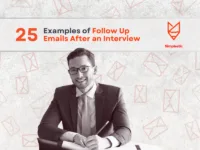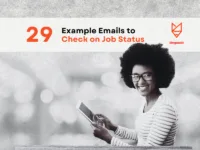Job Application Follow-Up Email | Effective Strategies for a Successful Inquiry
Crafting an effective follow-up can be straightforward. You’ll want to keep it professional and concise. Referencing your application date and expressing gratitude for the opportunity to apply can leave a positive impression. In this blog post, you will find helpful job application follow-up email examples that you can customize for your needs. This will make it easier for you to connect with potential employers and stand out in a competitive job market.
Following up on Your Job Application
A well-crafted follow-up email can make a significant impact in the hiring process. It serves as an opportunity to express your continued interest in the role and remind the employer of your qualifications. Here’s a guide to help you craft a professional, concise follow-up email.
Timing Your Follow-Up
It’s best to follow up 1-2 weeks after submitting your application. This gives the employer time to review applications without feeling rushed. If you had an interview, wait about a week before following up. Be sure to check the job posting for any specific decision-making timelines.
Employer Expectations
Employers expect candidates to follow up as it shows proactivity and genuine interest in the position. Keep your email polite, clear, and to the point, including the position you applied for, your application date, and your enthusiasm for the role.
Crafting Your Follow-Up Email
- Subject Line
Make it clear and concise to increase the chances of your email being read. Examples:
- “Follow-Up on Job Application – [Your Name]”
- “Thank You for the Interview Opportunity”
- Professional Format
Start with a polite greeting, using the hiring manager’s name if possible. If unsure, “Dear Hiring Team” is a safe option. Reference something specific from your interview or the job description to reinforce your interest. For example:
- “Thank you for the opportunity to interview for the [Position]. I enjoyed discussing how my background in [specific area] aligns with your team’s goals.”
- Polite Introduction
Express gratitude for the interview or the opportunity to apply, setting a positive tone.
- Remind of Interview
Mention the date of your interview and highlight a key discussion point. This helps the recruiter remember you. Example:
- “I appreciated our conversation on [date] about [topic].”
- Express Continued Interest
Reaffirm your excitement for the role. Mention why you’re a good fit, emphasizing key skills or experiences that align with the job. Example:
- “I’m still very excited about the possibility of joining your team at [Company Name], and I believe my skills in [skill] would be a great asset to your team.”
- Reference Attached Documents
If you are attaching additional materials like your resume or portfolio, mention them. For example:
- “I’ve attached my updated resume for your review, along with a recent project I completed.”
Finalizing the Email
Before sending your email, proofread it for clarity, tone, and accuracy. Use a professional signature that includes your full name, phone number, and email address.
Sending the Email
Choose the right time to send your follow-up—about one week after submission or interview. Ensure your subject line is clear and your message concise. Here’s a simple structure:
- Open with Gratitude: Thank them for considering your application.
- State Your Purpose: Mention you are following up on your application status.
- Reiterate Interest: Briefly highlight why you’re the best fit for the position.
- Close Politely: Thank them again and express your willingness to provide further information if needed.
Post-Send Actions
After sending your follow-up, keep an eye on your inbox. If there’s no response after a week, consider sending a second follow-up. Ensure any further communication remains polite and professional. If you do not hear back after your second follow-up, it may be time to explore other opportunities.
Job application follow-up email examples
5 Job Application Follow-up Examples
Example 1: Basic Follow-Up
Subject: Follow-Up on My Application
Dear [Hiring Manager’s Name],
I hope this message finds you well. I wanted to check in about my application for the [Job Title] position. I am very interested in the role and eager to hear about any updates.
Thank you for your time.
Best,
[Your Name]
Example 2: Specific Position Mention
Subject: Follow-Up on [Job Title] Application
Hi [Hiring Manager’s Name],
I am writing to follow up on my application for the [Job Title] position submitted on [Date]. I am excited about the opportunity to join your team and would love to know if there are any updates on my application status.
Thank you for your consideration.
Sincerely,
[Your Name]
Example 3: Expressing Enthusiasm
Subject: Checking In on My Application
Dear [Hiring Manager’s Name],
I hope you are doing well. I am following up regarding my application for the [Job Title] position. I remain very enthusiastic about the possibility of contributing to [Company Name] and look forward to any updates you can share.
Warm regards,
[Your Name]
Example 4: Mentioning Interview
Subject: Follow-Up After Interview
Hi [Hiring Manager’s Name],
Thank you for the opportunity to interview for the [Job Title] position on [Date]. I enjoyed our conversation and am very interested in the role. I would appreciate any updates you might have.
Best regards,
[Your Name]
Example 5: Networking Approach
Subject: Follow-Up and Networking
Dear [Hiring Manager’s Name],
I wanted to reach out and follow up on my application for the [Job Title] position. I also wanted to connect and see if there are other ways I can contribute to [Company Name]. Any updates would be appreciated.
Thank you,
[Your Name]
35 Professional Statements for Job Application Follow-up Emails
Here’s a comprehensive list of 35 professional statements for job application follow-up emails:
1. Polite Follow-Up (Initial Check-In)
- “I wanted to follow up on my application for [Job Title] submitted on [Date].”
- “I’m very interested in this opportunity and would appreciate any updates on the hiring timeline.”
- “Could you confirm if my application was received and is under review?”
- “I’m excited about the possibility of joining [Company] and wanted to reiterate my enthusiasm.”
- “Please let me know if you need additional materials from me to support my application.”
2. Reaffirming Interest
- “After learning more about [Company’s Project/Initiative], I’m even more eager to contribute my skills in [Area].”
- “My experience in [Skill] aligns perfectly with what you’re seeking—I’d love to discuss how I can add value.”
- “I remain very interested in this role and am happy to provide further details about my qualifications.”
- “This position excites me because [Specific Reason]—I’d welcome the chance to explore this further.”
- “Working at [Company] has long been a career goal of mine due to [Reason].”
3. Post-Interview Follow-Up
- “Thank you again for the insightful conversation about [Topic Discussed]—it reinforced my interest in the role.”
- “I’ve been reflecting on our discussion about [Challenge] and wanted to share an additional idea [Brief Suggestion].”
- “Could you share an updated timeline for next steps in the hiring process?”
- “I’d be happy to provide references or work samples if it would help your decision-making.”
- “It was a pleasure meeting [Interviewer Name]—their perspective on [Topic] gave me valuable insights.”
4. Addressing Gaps or Concerns
- “I noticed the job description emphasizes [Skill]—I’d like to highlight my experience in this area [Example].”
- “While my background is in [Industry X], my transferable skills in [Skill] would allow me to excel in this role.”
- “If there are reservations about my fit, I’d welcome the opportunity to address them directly.”
- “Since applying, I’ve [Taken Course/Earned Certification] to further prepare for this role.”
- “My unconventional career path gives me a unique perspective on [Relevant Challenge].”
5. Strategic Persistence
- “I’m checking in as I noticed the job posting is still live—is the position still open?”
- “I understand hiring timelines shift—would it help if I connected you with my former manager for a referral?”
- “If this role is on hold, I’d appreciate being considered for future openings in [Department].”
- “I’d be happy to meet informally with the team to demonstrate my skills in [Area].”
- “Given my track record in [Achievement], I’m confident I could hit the ground running.”
6. Networking Approach
- “[Mutual Contact] suggested I reach out—they thought my work in [Field] would interest you.”
- “I admired your recent article on [Topic]—it resonated with my approach to [Related Skill].”
- “Would you have 15 minutes to share advice for someone eager to break into [Industry] at [Company]?”
- “I’d love to learn how someone with my background could contribute to projects like [Specific Example].”
- “Your career journey inspires me—might you have time for an informational interview?”
7. Closing Strong
- “Thank you for considering my application—I’m happy to accommodate any next steps at your convenience.”
- “I’ll follow up in a week if I haven’t heard back, but please don’t hesitate to contact me sooner.”
- “I’m flexible for interviews and can provide additional materials upon request.”
- “This role aligns perfectly with my goals—I’d be thrilled to move forward in the process.”
- “I appreciate your time and hope to have the opportunity to contribute to your team.”
Frequently Asked Questions
Here are common questions people have about following up on job applications. These FAQs offer clear advice on timing, content, and how to express your interest respectfully.
How long should I wait before following up on a job application I’ve submitted?
You should wait about one to two weeks after submitting your application before following up. This gives the employer time to review applications. If the job posting states a specific timeline, follow that instead.
What should I include in a follow-up email to a potential employer after an interview?
Your follow-up email should thank the interviewer for their time. Mention something specific from the interview to remind them of your conversation. Express your enthusiasm for the role and your eagerness to hear back.
Can you provide a template for a follow-up email inquiring about the status of a job application?
Subject Line: Follow-Up on Job Application – [Your Name]
Dear [Employer’s Name],
I hope this message finds you well. I recently applied for the [Job Title] position and wanted to inquire about the status of my application. I am very interested in the opportunity and would appreciate any updates you can share.
Thank you for your time.
Best regards,
[Your Name]
[Your Contact Information]
Is it appropriate to send a follow-up email after I’ve submitted a resume, and what should it say?
Yes, it is appropriate to send a follow-up email. In the email, thank the employer for considering your application. Briefly restate your interest in the position and offer to provide any additional information if needed.
What are the best practices for writing a follow-up email while waiting for a job offer?
Keep your email brief and polite. Thank the employer again for the interview. Ask if there are any updates on the hiring process without sounding impatient. Maintain a positive tone throughout.
How can I follow up on a job application in a way that is polite yet shows my continued interest in the position?
Start with a polite greeting. Express your gratitude for the opportunity to apply. Clearly state that you remain enthusiastic about the role and are eager to hear about any updates in the hiring process.
When writing a job application follow-up email, you want to keep it clear, polite, and professional. Focus on key points such as introducing yourself, reminding the employer of the interview, expressing your interest in the position, and mentioning any attached documents.


